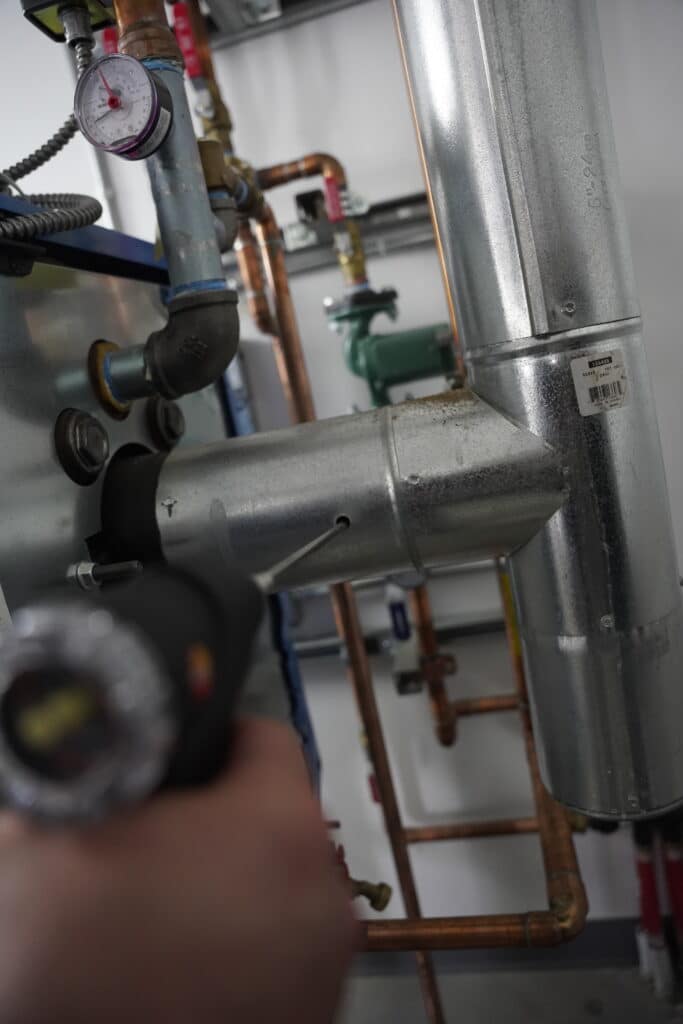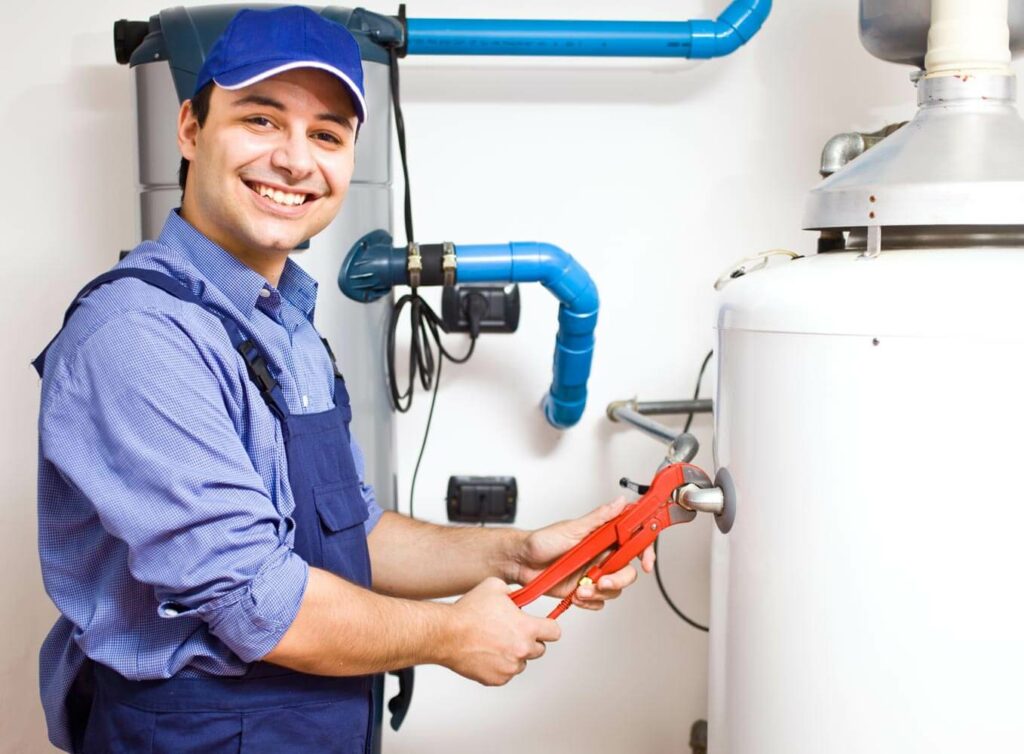Imagine stepping into the shower on a cold Monday morning, expecting a cascade of warm water, only to be greeted with an unexpected icy blast. Quite a chilling surprise, isn’t it? Welcome to the most common yet bothersome water heater issue that could mess up your day.
Prospector Plumbing is here to rescue you from these cold-water dilemmas by providing a comprehensive step-by-step guide on troubleshooting water heater issues. So, get ready for some plumbing enlightenment right from our expert plumbers and bid goodbye to those ice-cold showers!
This guide will educate you on identifying the root cause of your water heater woes and offer simple yet effective solutions that can help bring back those comforting hot showers into your life.
Identifying Water Heater Issues
Water heaters are an essential component of our daily lives, providing hot water for showers, dishwashing, and laundry. However, they can occasionally encounter problems that disrupt the flow of hot water. To address these issues effectively, it’s crucial to identify the source of the problem. Here are some common signs that indicate potential water heater issues:
- No Hot Water: If you turn on your faucet and there’s no hot water, it’s a clear sign that something is wrong with your water heater. This could be caused by a faulty heating element, a malfunctioning thermostat, or even a power supply issue.
- Inadequate Hot Water: If your water heater is producing lukewarm water or the hot water runs out quickly, there may be an issue with the capacity of your heater or sediment buildup in the tank. Sediment buildup can prevent efficient heating and reduce the amount of available hot water.
- Strange Noises: Unusual noises such as banging, popping, or rumbling coming from your water heater can indicate sediment accumulation at the bottom of the tank. This buildup can interfere with proper heating and damage the tank if left unaddressed.
- Leaks around the Water Heater: Any visible leaks around the water heater should not be ignored. Leaks can be caused by various factors, including a faulty temperature and pressure relief valve or a leaking pipe connection.
- Discolored or Smelly Water: If your hot water appears discolored (yellow or rusty) or has a foul odor, it may indicate rust inside the tank or bacteria growth. These issues should be addressed promptly for health and safety reasons.
It’s important to remember that these signs may not necessarily indicate a major problem; sometimes, they can be resolved with basic troubleshooting steps or minor repairs. However, if you’re unsure about addressing the issue yourself or if it persists after attempting troubleshooting, it’s advisable to seek professional assistance from a trusted plumbing service like Prospector Plumbing.
Diagnostic Steps for Water Heater Problems
When your water heater starts acting up, it can cause a lot of inconvenience and frustration. However, troubleshooting the issue doesn’t have to be a daunting task. By following a systematic approach, you can identify and resolve common problems with your water heater.
The first step in diagnosing water heater issues is to ensure that it is receiving power. Check if the circuit breaker associated with the water heater is turned on and hasn’t tripped. If the breaker has tripped, reset it and monitor if it trips again. This could indicate an electrical problem that needs further inspection.
Next, check the temperature setting on the thermostat. If the water isn’t reaching the desired temperature, turn up the thermostat gradually until you reach your preferred setting. Be cautious not to set it too high, as this can increase the risk of scalding and energy consumption.
If there’s no hot water at all, inspect the pilot light (if your water heater has one). Ensure that it is ignited and burning steadily. If not, follow the manufacturer’s instructions to relight it safely. A malfunctioning pilot light might require professional assistance to fix.
In cases where there’s a significant drop in hot water supply or fluctuations in temperature, sediment buildup within the tank could be to blame. Sediment accumulation reduces the efficiency of your water heater by insulating heating elements from water contact. Flushing out the tank periodically can help prevent sediment buildup and optimize performance.
When assessing water heaters, leaks are a critical issue to address promptly. Inspect the base of your water heater for any signs of leakage or moisture accumulation, as this indicates a potential problem with one of the fittings or pipes connected to the unit.
Let’s say you notice a pool of water forming around the base of your water heater. This could be an indicator of a faulty temperature and pressure relief valve or a leak in the tank itself. In such cases, it’s crucial to contact a professional plumber to further diagnose and repair the issue.
By following these diagnostic steps, you can gain valuable insights into the problems plaguing your water heater. However, some specific components require individual attention to ensure proper functioning. Let’s explore one such critical component in detail: the temperature and pressure relief valve.
- According to reporting from U.S. Energy Information Administration, 41.5 million Americans use electricity to heat their water, making potential water heater problems a widespread issue.
- Research indicates that a lack of regular maintenance is one of the leading causes of water heater failure, accounting for an estimated 27% of cases.
- The U.S. Department of Energy highlighted in a report that insulated water heaters or tanks can reduce standby heat loss by 25-45%, indicating that proper installation and maintenance enhance the functionality and efficiency of the appliance.

Temperature and Pressure Relief valve Checks
Temperature and pressure relief valves are essential safety mechanisms present in water heaters. They help regulate temperature and relieve excess pressure within the unit, preventing catastrophic malfunctions or explosions.
To check if your temperature and pressure relief valve is functioning correctly, start by locating it on the side of your water heater. Make sure there’s no visible damage or corrosion on the valve body, as this can affect its performance.
Next, perform a quick functionality test. Place a bucket underneath the discharge pipe connected to the valve. Lift the lever on the valve for a few seconds, allowing hot water to flow into the bucket. This action simulates a release of excess pressure from the tank and verifies that the valve is operating correctly.
If you notice any signs of leakage after performing this test, it may indicate a faulty temperature and pressure relief valve that needs replacement. A leaking valve poses a serious risk, as it compromises both the safety and proper functioning of your water heater.
Regularly checking and testing your temperature and pressure relief valves ensures optimal safety levels for your water heater. If you encounter any issues during these checks or have concerns about its performance, consult a professional plumber for further evaluation and repairs.
Heating Element and Thermostat Checks
When troubleshooting water heater issues, it’s crucial to begin by examining the heating element and thermostat. These components play an integral role in providing hot water efficiently. If you’re experiencing problems with your water heater, here are some checks you can perform on the heating element and thermostat.
Firstly, ensure that your water heater is turned off and disconnect the power supply. Access the heating element located at the bottom of the tank. Check for signs of corrosion, such as rust or mineral build-up, which could affect its performance. Using a multimeter, test the continuity of the heating element by checking if current flows through it.
If there is no continuity measured, it indicates a faulty heating element that needs to be replaced. On the other hand, if there is continuity, move on to examine the thermostat.
The thermostat controls and regulates the temperature of the water in your heater. Start by setting the thermostat to a higher temperature than usual and wait for it to kick in. If you don’t hear any clicking sounds or notice a change in temperature after about 15 minutes, there may be an issue with your thermostat.
To further diagnose the problem, carefully remove the access panel covering the thermostat. Inspect it for loose wires or signs of damage. Next, test the thermostat using a multimeter to measure its resistance. The readings should align with the desired temperature settings. Any significant deviation might indicate a faulty thermostat that requires replacement or adjustment.
For example, let’s say you set your thermostat to 120 degrees Fahrenheit, but the reading on your multimeter shows a resistance value significantly lower than expected. In this case, adjusting or replacing the thermostat can help resolve inconsistent water temperatures.
Remember, these checks should be performed with caution and preferably by a qualified professional. Water heaters involve electrical connections that can be dangerous if mishandled or improperly diagnosed.
Solutions to Water Heater Problems: A Step-by-Step Guide
Owning a water heater comes with its fair share of potential issues. However, many problems can be resolved without the need for professional intervention. Here is a step-by-step guide to help you troubleshoot and address common water heater problems.
- No Hot Water: If your water heater is not producing hot water, start by checking the power supply. Ensure that it is connected and functioning correctly. If the power supply is fine, test the heating elements using a multimeter as described earlier. Replace any faulty heating elements to restore hot water.
- Inadequate Hot Water: If your water heater isn’t delivering sufficient hot water, check the temperature settings on your thermostat. Adjust them accordingly and wait a few hours to see if the issue persists. It’s also important to clean up any sediment buildup at the bottom of the tank that may be obstructing heat transfer.
- Leaking Water: Water leakage is a serious concern and should be addressed promptly. Inspect all connections, valves, and pipes for signs of leaks or damage. Tighten loose fittings or replace faulty components as necessary. If the tank itself is leaking, it may require professional attention or replacement.
- Strange Noises: Unusual noises coming from your water heater could indicate sediment buildup or a worn-out heating element. To alleviate this issue, flush out the tank by draining it completely through the drain valve. This helps remove sediment and improves overall performance. Think of sediment buildup in your water heater as gunk clogging up your arteries – clearing it allows for proper flow and function.
- Pilot Light Issues: For gas-powered water heaters, a malfunctioning pilot light could be the culprit behind the lack of hot water. Follow the manufacturer’s instructions to relight the pilot light safely. If it continues to go out or won’t stay lit, there may be a faulty thermocouple that needs replacement.
Remember, while these solutions can address common water heater problems, it’s important to exercise caution and consult a professional plumber if you are unsure or uncomfortable with performing any of these steps.
Armed with this step-by-step guide, you’ll now have a better understanding of troubleshooting and resolving water heater issues on your own. By implementing these solutions, you can potentially save time and money on unnecessary repairs.
Discussion on Replacement or Repair Decisions
When it comes to troubleshooting water heater issues, one of the crucial considerations that homeowners often face is whether to repair or replace their water heater. This decision can be challenging, as various factors need to be taken into account. Let’s dive into this discussion to help you make an informed choice.
The age of your water heater plays a significant role in determining whether it’s time for a replacement. As a general rule of thumb, if your water heater is older than 10 to 15 years and experiencing frequent issues, it may be more cost-effective to replace it rather than invest in repairs. Older units are more prone to breakdowns, and repairing them could become a recurring expense.
However, the decision should not solely rely on age. If your water heater is relatively new and encountering minor problems like a faulty thermostat or leaking valve, repair might be the more sensible option. In such cases, engaging a professional plumber from Prospector Plumbing Services can help diagnose the issue accurately and provide reliable repair solutions.
Additionally, consider the overall efficiency of your current water heater. Imagine you have an old car that continuously requires costly repairs and consumes large amounts of fuel. It might make financial sense to invest in a newer model that offers better mileage and reliability. Similarly, if your water heater is inefficient and driving up energy bills due to its outdated technology, opting for a high-efficiency replacement can save you money in the long run.
Seeking Professional Help: Prospector Plumbing Services
When troubleshooting water heater issues, it’s crucial to recognize the value of professional expertise. While DIY fixes may seem tempting, it’s best to leave intricate plumbing tasks in the hands of experienced professionals like the ones at Prospector Plumbing.
Extensive Knowledge and Skill: The plumbers at Prospector Plumbing possess extensive knowledge about various types and models of water heaters. We have acquired the skills necessary to diagnose problems accurately and provide effective solutions tailored to your specific situation.
Safety and Compliance: Addressing water heater issues requires working with potentially hazardous components like gas lines or electrical connections. Without proper knowledge and training, attempting repairs yourself can pose safety risks. By engaging professionals from Prospector Plumbing, you ensure that all repairs and replacements adhere to safety regulations, minimizing potential hazards.
Moreover, working with professionals guarantees that all necessary permits and certifications are obtained in compliance with local codes. This ensures not only your safety but also protects against legal liabilities should any unforeseen incidents occur.
With our comprehensive understanding of water heater systems and commitment to delivering top-notch service, Prospector Plumbing Services is an ideal choice for troubleshooting and repairing water heater issues. Schedule an appointment with us today!

